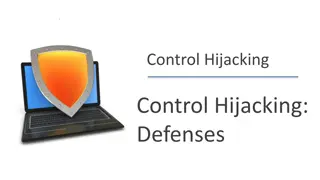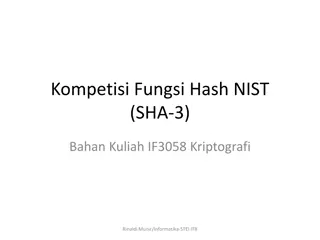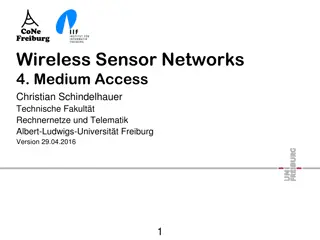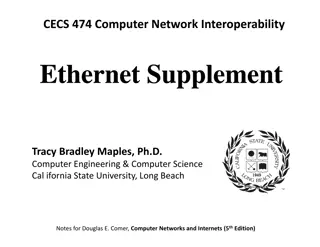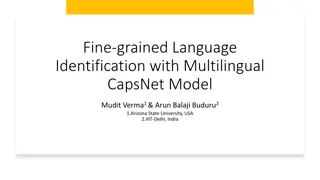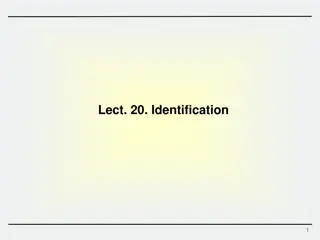Overview of Identification Protocols in CS255 by Dan Boneh
The lecture in CS255 covers various topics related to identification protocols, including signatures from trapdoor functions, certificates, revocation methods, certificate issuance problems, defense mechanisms like certificate transparency (CT), and moving on to protocols. The talk also explores the setup, applications of ID protocols in the physical world and on the internet, emphasizing security and authentication practices. Special focus is given to ensuring the correct issuance and usage of certificates to prevent fraudulent activities in the digital domain.
Download Presentation

Please find below an Image/Link to download the presentation.
The content on the website is provided AS IS for your information and personal use only. It may not be sold, licensed, or shared on other websites without obtaining consent from the author. Download presentation by click this link. If you encounter any issues during the download, it is possible that the publisher has removed the file from their server.
E N D
Presentation Transcript
CS255: identification protocols Announcements: HW#4 is out on the course web site Last lecture: guest lecture by Jennifer Granick, ACLU Dan Boneh
Quick recap Signatures: From trapdoor functions (such as RSA) From CRH (one-time sigs many-time sigs, good for software updates) From discrete-log: next week Certificates: bind a public key to an identity [ issuer-id, subject-id, PK, validity-period, serial #, ] + [CA sig] Revocation methods: expiration and CRLset (list of revoked serial #s) What if a CA incorrectly issues a cert to an adversary? Dan Boneh
Certificate wrong issuance: the problem GET https://bank.com BadCertForBank BankCert attacker ClientHello ClientHello bank ServerCert (rogue) (cert for Bank by a valid CA -- 1200 CAs) ServerCert (Bank) TLS key exchange TLS key exchange k2 k1 k1 k2 HTTP data enc with k1 HTTP data enc with k2 Person-in-the-middle attack: attacker sees all traffic, server cannot detect Dan Boneh
A defense: cert transparency (CT) Idea: CA s must push all certs. they issued to a public log Browser will only use a cert if it is published on (two) log servers Server attaches to certificate a signed statement from log (SCT) Companies can scan logs to look for invalid issuance (service by CA) April 30, 2018: CT required by chrome. Otherwise, cert is rejected. Dan Boneh
Part 3: Done with crypto primitives, moving on to protocols. ID protocols Overview Dan Boneh
The Setup vk either public or secret Alg. G sk vk User P (prover) Server V (verifier) yes/no no key exchange Dan Boneh
Applications: physical world Physical locks: (friend-or-foe) Wireless car entry system Opening an office door Login at a bank ATM or a desktop computer Dan Boneh
Applications: Internet Login to a remote web site after a key-exchange with one-sided authentication (e.g. HTTPS) ??? bank.com sk vk one-sided auth. key exchange Prover k Verifier k ID protocol Alice Dan Boneh
ID Protocols: how not to use ID protocol do not establish a secure session between Alice and Bob !! Not even when combined with anonymous key exch. Vulnerable to man in to the middle attacks ??? ??? sk vk anon. key exchange Prover k Verifier k ID protocol Alice Insecure! Dan Boneh
ID Protocols: how not to use ID protocol do not set up a secure session between Alice and Bob !! Not even when combined with anonymous key exch. Vulnerable to man in to the middle attack ??? ??? sk vk Prover ka Verifier key exch. key exch. ka kb kb proxy ID protocol Alice Dan Boneh
ID Protocols: Security Models 1. Direct Attacker: impersonates prover with no additional information (other than vk) Door lock 2. Eavesdropping attacker: impersonates prover after eavesdropping on a few conversations between prover and verifier Wireless car entry system 3. Active attacker: interrogates prover and then attempts to impersonate prover Fake ATM in shopping mall Dan Boneh
ID protocols Direct attacks Dan Boneh
Basic Password Protocol (incorrect version) PWD: finite set of passwords Algorithm G (KeyGen): choose pw PWD. output sk = vk = pw. sk User P (prover) Server V (verifier) yes iff sk=vk vk sk Dan Boneh
Basic Password Protocol (incorrect version) Problem: vk must be kept secret Compromise of server exposes all passwords Never store passwords in the clear! password file on server Alice pwalice Bob pwbob Dan Boneh
Basic Password Protocol: version 1 H: one-way hash function from PWD to X Given H(x) it is difficult to find y such that H(y)=H(x) sk password file on server User P (prover) Server V (verifier) Alice H(pwA) sk vk = H(sk) Bob H(pwB) yes iff H(sk)=vk Dan Boneh
Problem: Weak Password Choice Users frequently choose weak passwords: (SplashData, 2018, from more than 5 million passwords leaked on the Internet) 1. 123456 6. 111111 2. password 7. 1234567 3. 123456789 8. sunshine 4. 12345678 9. qwerty 5. 12345 10. iloveyou Dictionary of 360,000,000 words covers about 25% of user passwords Note: Google password checker Dan Boneh
The 25 top passwords on the list cover more than 10% of users Nearly 3% of people use the worst password, 123456. Online dictionary attack: attacker has a list of usernames. For each username the attacker tries the password 123456 . Success after 33 tries on average (!) Can be mitigated by e.g., IP-based rate limiting Dan Boneh
Offline Dictionary Attacks Suppose attacker obtains a single vk = H(pw) from server Offline attack: hash all words in Dict until a word w is found such that H(w) = vk Time O(|Dict|) per password Off the shelf tools (e.g. John the ripper): Scan through all 7-letter passwords in a few minutes Scan through 360,000,000 guesses in few seconds will recover 23% of passwords Dan Boneh
Batch Offline Dictionary Attacks Suppose attacker steals entire pwd file F Obtains hashed pwds for all users Example (2012): Linkedin (6M: SHA1(pwd) ) Alice H(pwA) Bob H(pwB) Batch dict. attack: For each w Dict: test if H(w) appears in F (using fast look-up) Total time: O( |Dict| + |F| ) [Linkedin: 6 days, 90% of pwds. recovered] Much better than attacking each password individually ! Dan Boneh
Preventing Batch Dictionary Attacks id S h Public salt: Alice SA H(pwA , SA) When setting password, pick a random n-bit salt S Bob SB H(pwB , SB) When verifying pw for A, test if H(pw, SA) = hA Recommended salt length, n = 64 bits Attacker must re-hash dictionary for each user Batch attack time is now: O( |Dict| |F| ) Dan Boneh
How to hash a password? Linked-in: SHA1 hashed (unsalted) passwords 6 days, 90% of passwords recovered by exhaustive search The problem: SHA1 is too fast attacker can try all words in a large dictionary To hash passwords: Use a keyed hash function (e.g., HMAC) where key stored in HSM In addition: use a slow, space-hard function Dan Boneh
How to hash? PBKDF2, bcrypt: slow hash functions Slowness by iterating a crypto hash function like SHA256 Example: H(pw) = SHA256(SHA256( SHA256(pw, SA) )) Number of iterations: set for 1000 evals/sec Unnoticeable to user, but makes offline dictionary attack harder Problem: custom hardware (ASIC) can evaluate hash function 50,000x faster than a commodity CPU attacker can do dictionary attack much faster than 1000 evals/sec. Dan Boneh
How to hash: a better approach Scrypt: a slow hash function AND need lots of memory to evaluate custom hardware not much faster than commodity CPU Problem: memory access pattern depends on input password local attacker can learn memory access pattern for a given password eliminates need for memory in an offline dictionary attack Is there a space-hard function where time is independent of pwd? Password hashing competition (2015): Argon2i (also Balloon) Dan Boneh
ID protocols Security against eavesdropping attacks (one-time password systems) Dan Boneh
Eavesdropping Security Model Adversary is given: Server s vk, and the transcript of several interactions between honest prover and verifier. (example: remote car unlock) adv. goal is to impersonate prover to verifier A protocol is secure against eavesdropping if no efficient adversary can win this game The password protocol is clearly insecure ! Dan Boneh
One-time passwords (secret vk, stateful) Setup(algorithm G): Choose random key k Output sk = (k,0) ; vk = (k,0) Identification: r0 F(k,0) r1 F(k,1) prover sk = (k,0) server vk = (k,0) Yes iff r = F(k,0) sk = (k,1) vk = (k,1) 6 digits often, time-based updates: r F(k, time) [stateless] Dan Boneh
The SecurID system (secret vk, stateful) Thm : if F is a secure PRF then protocol is secure against eavesdropping RSA SecurID uses AES-128: 128 bit key 32 bit ctr F 6 digit output Advancing state: sk (k, i+1) Time based: every 60 seconds (TOTP) User action: every button press Both systems allow for skew in the counter value Dan Boneh
TOTP: Google authenticator 6-digit timed one-time passwords (TOTP) based on [RFC 6238] To enable TOTP for a user: web site presents QR code with embedded data: otpauth://totp/Example:alice@dropbox.com? secret=JBSWY3DPEHPK3PXP & issuer=Example Subsequent user logins require user to present TOTP Dan Boneh
Server compromise exposes secrets March 2011: RSA announced servers attacked, secret keys stolen enabled SecurID user impersonation Is there an ID protocol where server key vk is public? Dan Boneh
The S/Key system (public vk, stateful) Notation: H(n)(x) = H(H( H(x) )) n times Algorithm G: (setup) Choose random key k K Output sk = (k,n) ; vk = H(n+1)(k) Identification: H(n-2)(k) H(n-1)(k) H(n)(k) H(n+1)(k) k H(k) vk pwd #4 pwd #3 pwd #2 pwd #1 Dan Boneh
The S/Key system (public vk, stateful) Identification (in detail): H(i)(k) ; set sk Prover (sk=(k,i)): send t (k,i-1) Verifier(vk=H(i+1)(k), t): if H(t)=vk then vk t, output yes Notes: vk can be made public; but need to generate new sk after n logins (n 106 ) Thm : S/Keyn is secure against eavesdropping (public vk) provided H is one-way on n-iterates Dan Boneh
SecurID vs. S/Key S/Key: public vk, limited number of authentications Long authenticator t (e.g., 80 bits) SecurID / TOTP: secret vk, unlimited number of authentications Short authenticator (6 digits) Dan Boneh
Online Cryptography Course Dan Boneh ID protocols Security against active attacks (challenge-response protocols) Dan Boneh
Active Attacks vk probe #1 User P (prover) Server V (verifier) probe #q impersonate sk vk Offline fake ATM: interacts with user; later tries to impersonate user to real ATM Offline phishing: phishing site interacts with user; later authenticates to real site All protocols so far are vulnerable Dan Boneh
MAC-based Challenge Response (secret vk) k K vk = k sk = k User P (prover) Server V (verifier) random m M sk t SMAC(k, m) vk VMAC(k, m, t) Thm : protocol is secure against active attacks (secret vk), provided (SMAC , VMAC) is a secure MAC and |M| 2128 Dan Boneh
MAC-based Challenge Response Problems: vk must be kept secret on server dictionary attack when k is a human pwd: Given [ m , SMAC (pw, m) ] eavesdropper can try all pw Dict to recover pw Main benefit: Both m and t can be short CryptoCard: 8 chars each Dan Boneh
Sig-based Challenge Response (public vk) Replace MAC with a digital signature: (sk, vk) GSIG vk sk User P (prover) Server V (verifier) random m M t Sign(sk, m) sk vk Verify(vk, m, t) Thm : Protocol is secure against active attacks (public vk), provided (GSIG ,Sign,Verify) is a secure digital sig. and |M| 2128 but t is long ( 20 bytes) Dan Boneh
Signature-based Challenge Response in the real world Dan Boneh
The Universal Second Factor (U2F) Standard (and WebAuthn) Goals: Browser malware cannot steal user credentials U2F should not enable tracking users across sites U2F uses counters to defend against token cloning U2F token service (github.com) browser Dan Boneh
The U2F protocol: two parts (simplified) Device registration: ID, challenge ID, challenge (pkID, handle) sk pkID, sigID, handle pkID, sigID, handle service (github.com) browser skID Authentication: ID, chal., handle verify sig. with pkID ID, chal., handle sk sigID, ctr sigID, ctr service skID browser Dan Boneh
The U2F protocol: two parts (simplified) Device registration: ID, challenge ID, challenge (pkID, handle) sk pkID, sigID, handle pkID, sigID, handle service (github.com) browser skID Authentication: Unlinkable pkID per site prevents user tracking across sites ID, chall., handle verify sig. with PKID ID, chall., handle sk sigID, ctr sigID, ctr service skID browser Dan Boneh
Summary ID protocols: useful in settings where adversary cannot interact with prover during impersonation attempt Three security models: Direct: passwords (properly salted and hashed) Eavesdropping attacks: One time passwords SecurID: secret vk, unbounded logins S/Key: public vk, bounded logins Active attacks: challenge-response Dan Boneh
THE END Dan Boneh










